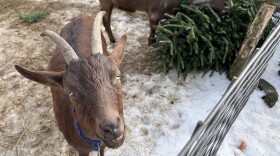Every year, deer ticks bite thousands of people in the Northeast. And as winters in the region become more mild, adult deer ticks are becoming more active at a time when they’re normally dormant – causing a bigger public health risk.
“It’s becoming a year-round, check-yourself-for-ticks situation,” said Dr. Toni Lyn Morelli with the Northeast Climate Adaptation Science Center.
Morelli said if temperatures are at or above 40 degrees Fahrenheit, adult deer ticks will emerge to seek hosts in the winter.
Data from the U.S. Global Change Research Program show that New England temperatures are rising faster than national and international averages. The largest increases in the region are happening during winter.
Deer ticks, also known as blacklegged ticks, can pass on Lyme disease, anaplasmosis and other sicknesses. Lyme in particular can cause chronic symptoms for some people.
“Everybody’s looking for the scapegoat when it comes to vector-borne diseases and ticks and tick-borne diseases,” said Dr. Megan Linske with the Connecticut Agricultural Experiment Station. “I think climate change is a big one.”Testing ‘ticks of concern’ in a Connecticut lab
In New England, there is little active tick surveillance in winter, which requires going outdoors to collect ticks.
Instead, the Connecticut Agricultural Experiment Station runs a passive tick surveillance program to determine whether a tick bite gave someone a disease. Connecticut residents either drop off ticks they pulled off people or a pet, or mail them into the lab in New Haven, Connecticut.
On a day in February, Entomology Department head Dr. Goudarz Molaei tested a female adult deer tick that was sent in. It was so swollen that it was almost unrecognizable. The tick might have fed for several days, Molaei said, which could make it more likely to transmit an infection.
“This is a fully engorged tick,” Molaei said. ”It is a tick of concern.”

And his lab is seeing lots and lots of ticks.
From December into late February, he said 275 tick samples arrived at his lab, which is much more than past winters. Noelle Khalil, a research technician with the lab, placed the fully engorged tick in a vial, added liquids, and shook it all up to break up the tissue before putting it into a centrifuge.
“It’s going to spin all this debris you see to the bottom,” Khalil said, holding up the small mixture.
Results take a few days to come back after more steps and a PCR test.
Data from the Centers for Disease Control and Prevention (CDC) show that national Lyme disease rates have been steadily increasing, with New England experiencing the biggest increase in cases and overall infections.
Meanwhile, Northeast Regional Climate Center data show that average regional temperatures from November to January were 1 to 7 degrees higher than normal for half of the last decade.
Linske, with the Connecticut Agricultural Experiment Station, said continued warming could lead to greater populations of native and non-native ticks.
“Without that limiting factor of winter, we’re going to see more of those pop up. And we’re going to see more of them establish in the Northeast as well,” she said.

Learning to live alongside more ticks
Chantal Foster is an avid hiker from central Connecticut and no stranger to ticks. Her dog has had Lyme disease before and recovered, but Foster hasn’t had it. Just this February, she said she picked ticks off her dog after two hikes. Foster is careful that she and her dog don’t get bitten.
“If you’re just paying attention to what you’re doing, you should be OK,” she said. “That’s not to say that it can’t happen, but I’m not going to not go outside.”
In 2019, Linske co-authored a study examining winter deer tick survival in coastal New England. One finding was that as the mean temperature increased, so did nymphal tick survival.
Linske said that while they research how to manage tick populations, people in the Northeast must learn to coexist with them year-round. Whether it’s the backyard or the woods, the CDC advises avoiding brushy, wooded areas, tall grass and leaf litter – and doing a full body check of people and pets afterward.
“It’s being more cognizant of the ticks that are on the landscape and the potential diseases that they may carry with them,” Linske said, adding that in her work monitoring ticks, she hasn’t caught Lyme. “And I think it’s because we’re vigilant.”





